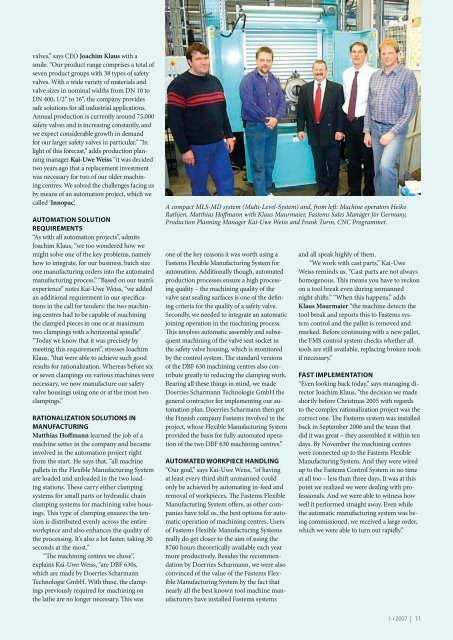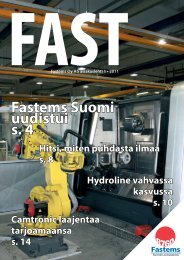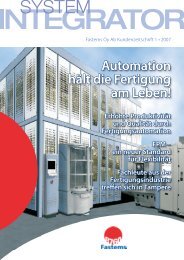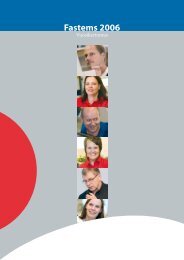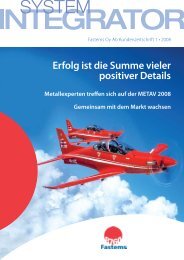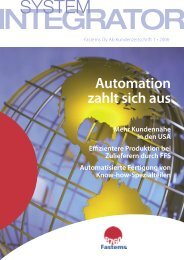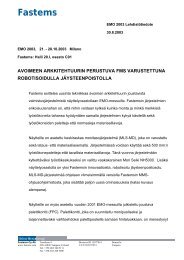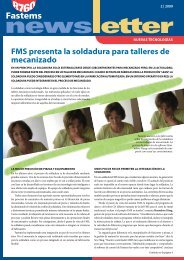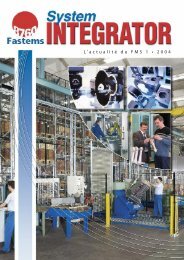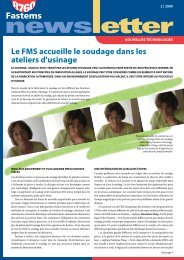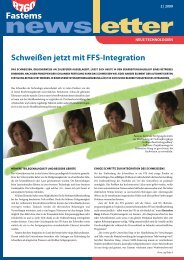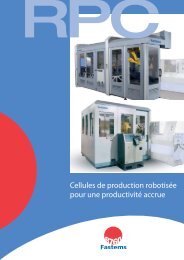Automation keeps manufacturing alive! - Fastems
Automation keeps manufacturing alive! - Fastems
Automation keeps manufacturing alive! - Fastems
Create successful ePaper yourself
Turn your PDF publications into a flip-book with our unique Google optimized e-Paper software.
valves,” says CEO Joachim Klaus with a<br />
smile. “Our product range comprises a total of<br />
seven product groups with 38 types of safety<br />
valves. With a wide variety of materials and<br />
valve sizes in nominal widths from DN 10 to<br />
DN 400, 1/2“ to 16“, the company provides<br />
safe solutions for all industrial applications.<br />
Annual production is currently around 75,000<br />
safety valves and is increasing constantly, and<br />
we expect considerable growth in demand<br />
for our larger safety valves in particular.” “In<br />
light of this forecast,” adds production planning<br />
manager Kai‑Uwe Weiss “it was decided<br />
two years ago that a replacement investment<br />
was necessary for two of our older machining<br />
centres. We solved the challenges facing us<br />
by means of an automation project, which we<br />
called ‘Innopac’.<br />
automation solution<br />
requirements<br />
“As with all automation projects”, admits<br />
Joachim Klaus, “we too wondered how we<br />
might solve one of the key problems, namely<br />
how to integrate, for our business, batch size<br />
one <strong>manufacturing</strong> orders into the automated<br />
<strong>manufacturing</strong> process.” “Based on our team’s<br />
experience” notes Kai-Uwe Weiss, “we added<br />
an additional requirement in our specifications<br />
in the call for tenders: the two machining<br />
centres had to be capable of machining<br />
the clamped pieces in one or at maximum<br />
two clampings with a horizontal spindle”<br />
“Today we know that it was precisely by<br />
meeting this requirement”, stresses Joachim<br />
Klaus, “that were able to achieve such good<br />
results for rationalization. Whereas before six<br />
or seven clampings on various machines were<br />
necessary, we now manufacture our safety<br />
valve housings using one or at the most two<br />
clampings.”<br />
rationalization solutions in<br />
<strong>manufacturing</strong><br />
Matthias Hoffmann learned the job of a<br />
machine setter in the company and became<br />
involved in the automation project right<br />
from the start. He says that, “all machine<br />
pallets in the Flexible Manufacturing System<br />
are loaded and unloaded in the two loading<br />
stations. These carry either clamping<br />
systems for small parts or hydraulic chain<br />
clamping systems for machining valve housings.<br />
This type of clamping ensures the tension<br />
is distributed evenly across the entire<br />
workpiece and also enhances the quality of<br />
the processing. It’s also a lot faster, taking 30<br />
seconds at the most.”<br />
“The machining centres we chose”,<br />
explains Kai-Uwe Weiss, “are DBF 630s,<br />
which are made by Doerries Scharmann<br />
Technologie GmbH. With these, the clampings<br />
previously required for machining on<br />
the lathe are no longer necessary. This was<br />
A compact MLS-MD system (Multi-Level-System) and, from left: Machine operators Heiko<br />
Rathjen, Matthias Hoffmann with Klaus Maurmaier, <strong>Fastems</strong> Sales Manager for Germany,<br />
Production Planning Manager Kai-Uwe Weiss and Frank Turm, CNC Programmer.<br />
one of the key reasons it was worth using a<br />
<strong>Fastems</strong> Flexible Manufacturing System for<br />
automation. Additionally though, automated<br />
production processes ensure a high processing<br />
quality – the machining quality of the<br />
valve seat sealing surfaces is one of the defining<br />
criteria for the quality of a safety valve.<br />
Secondly, we needed to integrate an automatic<br />
joining operation in the machining process.<br />
This involves automatic assembly and subsequent<br />
machining of the valve seat socket in<br />
the safety valve housing, which is monitored<br />
by the control system. The standard versions<br />
of the DBF 630 machining centres also contribute<br />
greatly to reducing the clamping work.<br />
Bearing all these things in mind, we made<br />
Doerries Scharmann Technologie GmbH the<br />
general contractor for implementing our automation<br />
plan. Doerries Scharmann then got<br />
the Finnish company <strong>Fastems</strong> involved in the<br />
project, whose Flexible Manufacturing System<br />
provided the basis for fully automated operation<br />
of the two DBF 630 machining centres.”<br />
automated worKpiece handling<br />
“Our goal,” says Kai-Uwe Weiss, “of having<br />
at least every third shift unmanned could<br />
only be achieved by automating in-feed and<br />
removal of workpieces. The <strong>Fastems</strong> Flexible<br />
Manufacturing System offers, as other companies<br />
have told us, the best options for automatic<br />
operation of machining centres. Users<br />
of <strong>Fastems</strong> Flexible Manufacturing Systems<br />
really do get closer to the aim of using the<br />
8760 hours theoretically available each year<br />
more productively. Besides the recommendation<br />
by Doerries Scharmann, we were also<br />
convinced of the value of the <strong>Fastems</strong> Flexible<br />
Manufacturing System by the fact that<br />
nearly all the best known tool machine manufacturers<br />
have installed <strong>Fastems</strong> systems<br />
and all speak highly of them.<br />
“We work with cast parts,” Kai-Uwe<br />
Weiss reminds us. “Cast parts are not always<br />
homogenous. This means you have to reckon<br />
on a tool break even during unmanned<br />
night shifts.” “When this happens,” adds<br />
Klaus Maurmaier “the machine detects the<br />
tool break and reports this to <strong>Fastems</strong> system<br />
control and the pallet is removed and<br />
marked. Before continuing with a new pallet,<br />
the FMS control system checks whether all<br />
tools are still available, replacing broken tools<br />
if necessary.”<br />
fast implementation<br />
“Even looking back today,” says managing director<br />
Joachim Klaus, “the decision we made<br />
shortly before Christmas 2005 with regards<br />
to the complex rationalization project was the<br />
correct one. The <strong>Fastems</strong> system was installed<br />
back in September 2006 and the team that<br />
did it was great – they assembled it within ten<br />
days. By November the machining centres<br />
were connected up to the <strong>Fastems</strong> Flexible<br />
Manufacturing System. And they were wired<br />
up to the <strong>Fastems</strong> Control System in no time<br />
at all too – less than three days. It was at this<br />
point we realized we were dealing with professionals.<br />
And we were able to witness how<br />
well it performed straight away. Even while<br />
the automatic <strong>manufacturing</strong> system was being<br />
commissioned, we received a large order,<br />
which we were able to turn out rapidly.”<br />
1 • 2007 | 11


